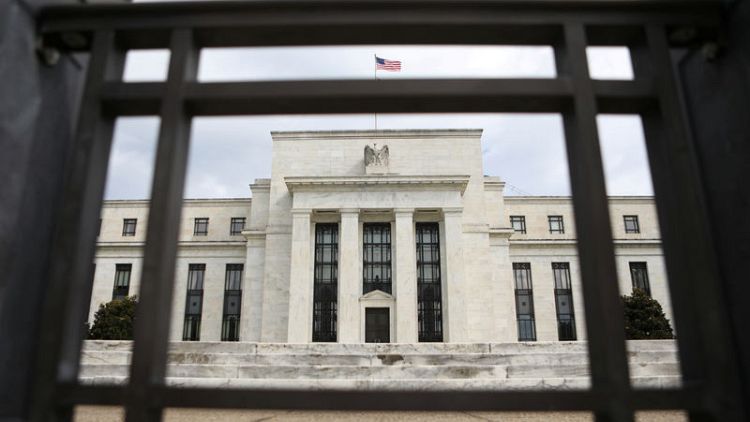By Howard Schneider
WASHINGTON (Reuters) - Ebbing global growth and shaky financial markets threw the U.S. Federal Reserve off course in early 2016, and it took nearly a year for officials to regain confidence growth would continue and convince investors they would again raise interest rates.
Similar conditions confront Fed policymakers as they meet this week, with market scepticism about further rate hikes as deep as it was three years ago, and a stalemate over global trade, a U.S. federal government shutdown, and waning business and consumer confidence further clouding the picture. (Graphic: https://tmsnrt.rs/2B6xrKy)
Policymakers have been clear they plan a "patient" pause in rate hikes. The challenge for Fed chairman Jerome Powell is how much of a pause to signal without leaving the public convinced that the Fed's current cycle of rising interest rates has come to a full stop.
"Realistically it is a second half of the year story," for the Fed to feel secure the U.S. recovery is sturdy enough to warrant further rate increases, said Robin Brooks, chief economist for the Institute of International Finance. While some current conditions are healthier than they were in 2016, with historically low unemployment, for example, "what's different on the negative side is the sheer amount of noise in the system."
That includes issues, such as the U.S.-China trade spat that could be resolved soon, clear away some of the doubts that are holding back business spending, and improve the Fed's outlook.
But policymakers are now in no rush, with some framing the likely pause in terms of "months" that may be needed for risks to subside enough for them to approve the next of two rates hikes expected for the year.
Even that may be optimistic. While economists polled by Reuters this month see those hikes delayed by a quarter compared with a December survey, financial markets do not price in any rate increases in 2019. [nKCN1ON13U https://www.reuters.com/article/us-usa-fed-futures/rate-futures-market-says-fed-is-all-but-done-with-hikes-idUSKCN1ON13U]
Some economists now argue the central bank's next move will be to loosen monetary policy - whether through a rate cut, or slowing the monthly rundown of the Fed's balance sheet that acts as a further, if small, tightening of economic conditions each month.
The drawdown of the balance sheet by up to $50 billion a month was designed as a non-controversial way to reverse the Fed's accumulation of trillions of dollars during the financial crisis a decade ago. But there has been increasing pressure -- from markets and President Donald Trump - for the central bank to slow the process or stop altogether.
BALANCING ACT
The Fed "needs a graceful way to back off" a three-year-old tightening cycle that was expected to continue into next year, wrote Steven Blitz, U.S. economist for TS Lombard. He said he anticipated the Fed will signal its new plans by changing the balance sheet program at this meeting or the next one in March, then be forced to cut rates later in the year.
The Jan. 29-30 Fed meeting this week is the first of 2019. There will be no updated rate or economic projections from policymakers, but Powell is set to hold the first of eight post-meeting news conferences scheduled for the year, one after every session of the Federal Open Market Committee.
It marks a change from the previous practice of briefing the media after every other meeting, a step Powell said will increase public transparency, and force investors to treat each Fed session the same.
It also doubles the chance for a communications misstep, and next week's appearance will pose a "delicate" communications as Powell weighs the fact that a strong U.S. economy may warrant higher rates against slowing world growth and financial markets flashing recession fears, said J.P. Morgan economist Michael Feroli said in a preview analysis of the coming Fed session.
"We think they will try to avoid giving the impression that pause equals stop (or even cut) or that the economic outlook has materially downshifted."
The Fed has rarely followed an extended pause in rate increases with a renewed push higher. The last time it did was in the mid-1990s during the "Great Moderation" period of steady growth and surging productivity.
Yet that is what Powell may have to engineer, soothing for now anyone nervous about the depth of a possible slowdown without promising that rates will not go up anymore, and clarifying along the way what may happen with the balance sheet.
"The essential debate...is whether the FOMC would still prefer to signal to the market that the next change in interest rates is likely higher or whether it should emphasize patience and remove rate guidance altogether," Barclays economist Michael Gapen wrote. The latter, he said, may calm markets today, but set the stage "for undesirable volatility later" if the Fed does need to hike again.
Graphic - Fed funds futures: https://tmsnrt.rs/2S6kRol
(Reporting by Howard Schneider; Editing by Tomasz Janowski)



